When you go to the trouble of smoking ribs at home, you want the very best flavor, something that you just can’t get when you’re eating out. To achieve this, you’ll need the best wood for smoking ribs to give your recipe the edge.
Let’s take an in-depth look at what types of wood are commonly used for smoking ribs. We’ll also focus on which types of wood you should avoid, as well as discovering what the pros use to get the best smoked rib flavor.
Contents
- 1 How Does Wood Affect the Flavor of Smoked Ribs?
- 2 Best Smoking Wood for Ribs
- 3 Wood You Shouldn’t Use to Smoke Ribs
- 4 Should You Use Chips, Chunks, or Pellets for Ribs?
- 5 Can I Use Multiple Types of Wood?
- 6 Can You Use Too Much Wood When Smoking Meat?
- 7 Should You Soak Your Wood?
- 8 What Wood Do the Big BBQ Names Use?
- 9 Top Wood for Ribs Video
- 10 Final Thoughts
How Does Wood Affect the Flavor of Smoked Ribs?
Charcoal or gas are generally used to smoke ribs, alongside the occasional electric or pellet smoker. These smoking methods give us the heat and control that are essential for an expertly cooked rack of ribs. However, they do not provide the flavor and aroma that wood provides when smoking.
Even burning charcoal will not give you anything like the same flavor – charcoal produces minimal smoke when burnt. So, how does wood actually affect the flavor of our smoked ribs?
Burning wood releases a combination of over 100 different compounds, out of which trace amounts of the organic compounds syringol and guaiacol give us that smoky aroma and taste.
When you add wood chips to your smoker, the smoke rises up, flavoring the outer layer of your ribs. Each different type of wood imparts its own flavor which can also vary hugely within one variety depending upon the area where the tree was grown.
From mild, sweet flavors to strong, almost bitter spicy aromas, your choice of wood will have a huge impact upon the overall flavor of your finished smoked ribs.
Best Smoking Wood for Ribs
Here are some of the best smoking woods for ribs. First of all, we’ll take a close-up look at some of the most commonly available smoking woods, such as hickory and mesquite.
While these strong-flavored woods are not recommended for use on their own with pork ribs being better suited to beef brisket and other “meatier-tasting” cuts, they can impart extra flavor when combined with our preferred choice of milder fruitwoods.
Overall, our favorite wood for smoking ribs has to be apple for its sweet, mild flavor. Plus, as it’s a slow burner it’s ideal for cooking your ribs low and slow for moist, tender results.
Ideally, for a little extra smoky tang, you could mix in a little hickory or combine several other fruitwoods, such as cherry or peach, if you’re looking for a more subtle smoky flavor. Here’s what you need to know about each type of smoking wood for ribs.
Hickory
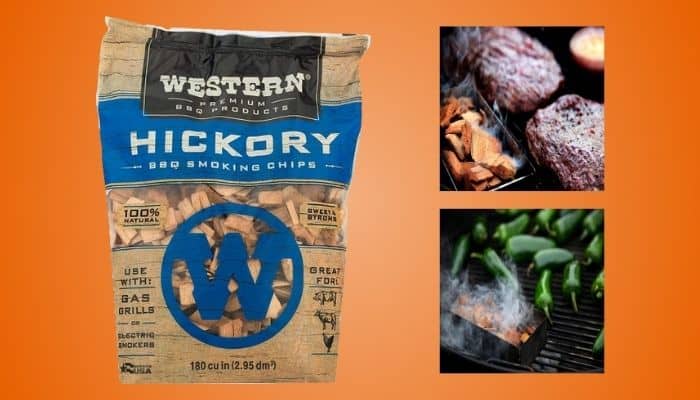
Hickory is a popular choice for smoking meats and is traditionally found across southern and midwestern states. It not only imparts a lot of smoky flavor, it also burns well being dense and heavy-grained, easily reaching high temperatures.
Flavorwise, hickory is often said to have a strong, bacon-like flavor when used for smoking meats. However, it is easily overdone, hence our recommendation to use hickory sparingly and mixed in with another milder type of wood. While big racks of ribs may be able to take on the flavor punch from hickory alone, it all depends on your tastebuds and smoking preferences.
If you only have hickory to hand and want to give it a go smoking your rack of ribs, make sure that you don’t overdo it and add a small amount to avoid ending up with an overly bitter smoke flavor to your ribs.
Mesquite
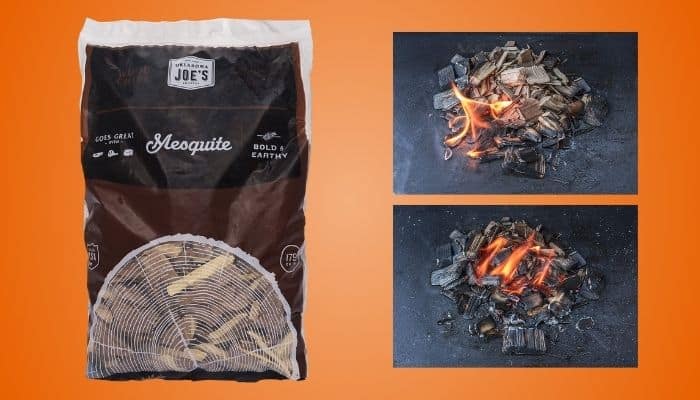
Mesquite is generally recommended for use with dark, rich-tasting meats that can take on its strong flavor. Intense and earthy, mesquite burns hot and fast, another reason it is best suited to quick-cooking meats like steak.
High in lignin, mesquite is one of the smokiest woods around, giving it such a strong smoke flavor that it can easily overpower poultry, pork shoulders, and… ribs. Easily identifiable from your very first bite, if you really enjoy a very strong smoke flavor, you could add a chunk or two of mesquite to some other milder flavored woods for smoking ribs.
Alternatively, if you are looking to try out smoking beef ribs, mesquite could make a smart choice, either used sparingly alone, or in combination with oak or fruitwoods. Mesquite definitely packs enough of a punch flavorwise to take on strong red meat, just make sure you don’t overdo it or you could end up with a bitter-tasting, harsh result.
Pecan
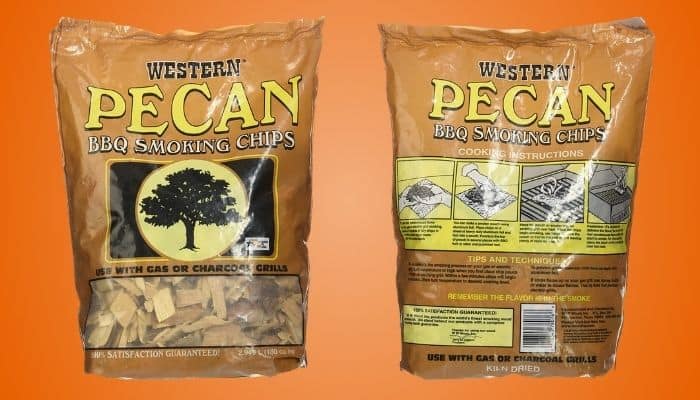
If you like a good smoky flavor but don’t want to risk overpowering your pork ribs with mesquite or hickory, the smart choice would be to choose pecan wood. Pecan is actually a type of hickory wood that is most famous for its nuts and use for furniture building. It is also, however, an excellent choice for smoking meats, including ribs.
Pecan is stronger in flavor than other fruitwoods, but not as strong as mesquite and hickory, giving you a good smoke flavor that has hints of sweetness and nuttiness for greater complexity. Pick up a bag of pecan wood for smoking your ribs and you can also use it with beef, poultry, game… in fact, it goes with just about everything, making it a great all-purpose smoking wood that you can use to add extra flavor to all of your smoked dishes.
Pecan can be used alone or combined with other fruitwoods for a richer palette of smoky flavors with extra sweetness that makes a good match for pork ribs. While our favorite overall has to be applewood for smoking ribs, if you prefer a less subtle smoky flavor, then pecan would be a better choice for you.
Apple

Apple is our overall favorite wood for smoking ribs. It imparts a subtle fruity smoke flavor that has hints of sweetness that work really well with ribs and pork in general.
As it is milder than woods such as hickory and mesquite, it is, in our opinion, a much better all-around choice for smoking meats over the course of several hours – after which mesquite can taste a little bitter.
Readily available throughout the year, applewood can be mixed with hickory or oak, or combined with other fruitwoods such as pecan or cherry, depending on how much smoke and what flavors you are looking for. If you find applewood is too subtle for your liking after a five hour smoke, adding a small amount of hickory to your next batch should do the trick.
As applewood burns slow, it is ideal for low ‘n’ slow cooking in your smoker. Plus it also complements pretty much all meats, although you won’t want to smoke delicate white meats for too long with it as it can become overwhelming.
All in all, applewood makes a great choice for smoking ribs and is definitely the one that we recommend trying out first.
Cherry
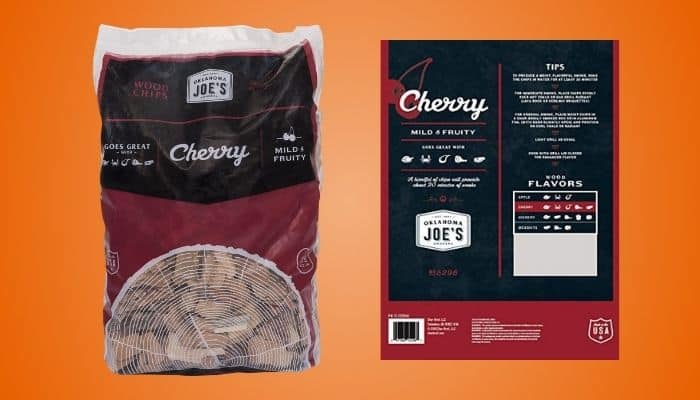
Cherrywood is another popular fruit wood for smoking.
Mild and light, it imparts a sweet smoky flavor that compliments most ribs, although if you are looking for a stronger smoky flavor that can better compete with a powerful spice rub, you may want to throw in some hickory for greater depth.
Cherry is also a good choice to mix in with oak for a more sustained flavor, without too much bitterness. Similarly, you could also blend it with pecan for an extra boost of smokiness and a more complex depth of flavor.
Pick up some cherrywood for your next rib grilling session and you’ll be able to use it to smoke pretty much any other dish, even vegetables can benefit from a quick smoke with cherrywood.
Cherry can give your meat a pink-red hue, making it a nice addition to throw into your smoking mix if you are looking to add extra depth of color to your ribs and other smoked meats.
Oak

Stronger in flavor than fruitwoods, but less powerful than hickory and mesquite, Oak is a good versatile wood that goes with just about everything, including ribs. Use it alone, or blend it with other woods; oak is widely used in commercial smoking and gives a good medium smoky flavor.
Smoking with oakwood will give you a nice brown hue to your ribs. If you are looking for extra smoke flavor, add in some hickory, or use oak to add extra depth to cherry or apple, without overpowering their more subtle flavorings.
An increasingly popular type of oak wood for smoking, whisky oak is a definite pitmaster’s favorite made from old oak whiskey barrels. Combining oak’s medium strength smoke with the complex subtleties of sweet whisky aromas, everyone should try ribs smoked with whiskey oak at least once, it’s a definite winning combination.
Peach
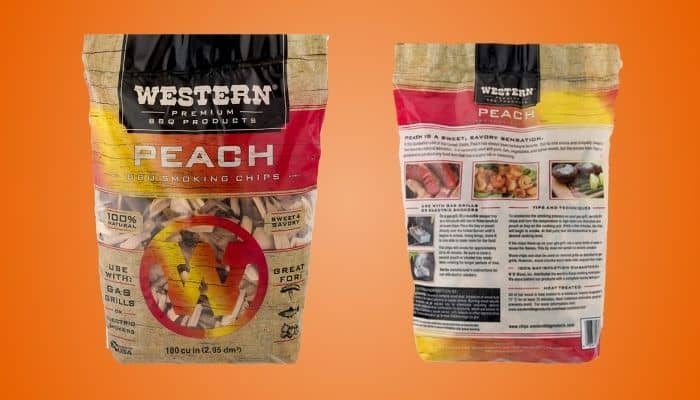
Peach is another popular choice for smoking ribs, especially in southeastern states. Mild with a light, almost sweet tang, peach wood goes well with most food types, especially if you are looking for wood for smoking ribs with a sweet seasoning.
Use peach with other fruitwoods to create a larger palette of flavors or combine it with oak. This will up the strength of your smoke flavor without overpowering your peachwood’s subtle taste. Peachwood puts out a medium amount of energy making it a good wood to use for low ‘n’ slow smoking sessions that last several hours.
Peachwood is often likened to pearwood for its similar flavor profile and smoke output. If peachwood is unavailable in your area, pear makes a good substitute, although you should bear in mind that pear burns a lot higher than medium-burning peach.
Maple

Maple is a good choice for smoking ribs, imparting a mild smoke flavor with a subtle hint of sweetness. If you are looking to add a light smoke flavor to your ribs, maple is the one to go for and it also makes a great pairing for a sticky sweet BBQ sauce.
High burning with a mild smoke output and good embers, smoking with maple will give your ribs a good brown color and won’t over-compete with your rubs, sauces, or marinades. Aside from smoking ribs, maple is a great choice for lightly flavoring poultry, beef, game, vegetables, and even eggs.
Use maple on its own for a light hint of smoke or combine it with heavier smoke-flavored woods, like hickory and mesquite, for greater balance and to tone down any bitter overtones. If you are less keen on strong smoke flavoring, combine maple with pecan or other fruitwoods for a milder, sweeter taste.
| Some more great grill tool guides |
|---|
| Great Rib Racks |
| 3-2-1 Rib |
| Different Ribs |
| Removing the Rib Membrane |
| Reheating Ribs |
Wood You Shouldn’t Use to Smoke Ribs
As you can tell from the previous list, there are plenty of options to try out when looking for the best wood for smoking ribs. However, not all woods are suitable for smoking – here are the main types of wood that you should definitely not use to smoke ribs.
Do not use softwoods
Softwoods are not suitable for use in your smoker. They contain high levels of sap and when burnt they will make your meat taste strange. Examples of softwoods to avoid using in your smoker include:
- Pine
- Cedar
- Spruce
- Fir
- Cyprus
Do not use wood you’ve collected without verifying its provenance
Some wood can be poisonous or irritant even when burnt. If you are unsure of your wood’s type, you should not use it for cooking your food. The following woods are to be avoided :
- Laburnum
- Oleander
- Yew
- Poisonous walnut
Do not use lumber/treated/painted wood
Most lumber is treated with chemicals that you really don’t want to be breathing in. It’s also not smart to have your food sitting in chemical-laden smoke. Painted wood or wood that has been treated with any kind of chemicals should not be used for smoking.
Do not use damp or moldy wood
Molds can contain dangerous toxins that you don’t want to be breathing in or even to have around your family.
Not only does dry wood burn better, it is also the safest option, as it is less likely to harbor potentially dangerous spores or toxins compared to wood that was recently alive.
Manufacturers of premium wood chips for smoking systematically heat-treat wood chips to ensure that they are free from pests, rot, and mold.
Should You Use Chips, Chunks, or Pellets for Ribs?
If you have a pellet grill, then you are going to be using wood pellets for smoking your ribs. Pellet grills are very clean-burning, so you won’t get a lot of smoke. Make sure that you are using good quality, hardwood pellets for the best results.
For the rest of us, it comes down to a choice between wood chips or wood chunks and which one is best for smoking, alongside any constraints related to your grill type.
Wood chips
Wood chips are by-products from various wood industries. They consist of shavings and scraps, typically sized between around one-quarter of an inch thick and up to one inch in length.
As they are so small, they burn through real quick, meaning they are not a good choice for long smoking sessions. They can, however, be a good option for a quick burst of smoke when grilling fast-cooking items such as fish or thin cuts of meat.
Wood chunks
Thanks to their larger size, wood chunks are the best choice for smoking low ‘n’ slow, giving you a good, long burn time. This also equates to extra flavor with wood chunks producing more smoke than chips.
This makes wood chunks the best choice for smoking ribs, as well as for smoking in general. While they take longer to get started, their superior burn time means you won’t have to replace them as frequently as wood chips that generally turn to ash before managing to impart much of a smoky flavor.
Can you use wood chunks in a gas or electric smoker?
While wood chunks are the best choice for smoking, unfortunately, not all types of smoker are designed to be used with wood chunks.
Obviously, you’ll have no issues using wood chunks with your charcoal grill. However, while some electric and gas smokers can accommodate wood chunks, others have very short smoker trays and only recommend using chips.
Before using wood chunks in your gas or electric smoker, check the manufacturer’s recommendations to make sure that your particular model can take wood chunks.
Can I Use Multiple Types of Wood?
Yes, you can use multiple types of wood when smoking. In fact, in some cases, it’s even recommended.
First of all, if you are new to smoking, make sure that you get all of your other smoking basics sorted before you start playing about with different wood combinations. No matter how good your combinations of wood are for smoking, focus first on getting your temperature and fire control just right.
Once you’re happy with using your smoker and you’re getting some good results, you can start to play with different combinations. While your specific tastes will likely differ from the next person’s, it makes sense to start out with some tried and tested pairs and slowly adjust to suit your palette.
Match mild woods with stronger smokier ones, for example, hickory and oak. If you are looking for a medium amount of smoke flavoring, you might like to try out pecan with another fruitwood, such as apple. For a more subtle hint of smokiness, try using two fruitwoods, such as cherry and apple, or apple with another mild smoking wood such as oak.
Over time, with plenty of practice, you’ll be able to find the best combination of different types of wood to smoke your ribs to perfection.
Can You Use Too Much Wood When Smoking Meat?
Yes, in the quest for extra flavor, using too much wood will create too much smoke. This can make your ribs taste bitter or even like ash. Each smoker is different, as is each type of wood, and your personal preferences as to how smoky you want your ribs to be.
We recommend starting out with two ounces of wood for your average rack of ribs. When it’s all burnt through and you no longer have any smoke, replace it with another two ounces.
Continue throughout your cook, up to a total of eight ounces for ribs. After tasting, decide if the flavor is enough and if it’s too much or too little, adjust your quantities accordingly during your next smoking session.
Note that if you are smoking with gas, you may want to start with three or four ounces instead of two as gas grills have superior ventilation, so your meat won’t take on as much flavor as with a charcoal grill.
Should You Soak Your Wood?
No, you really don’t need to soak your wood.
Think about it logically, you spend your money on kiln-dried wood and do your best to keep your smoker at a steady even temperature for the best results smoking your expensive meats. Wood floats, it does not absorb a lot of water easily, at least not within a couple of hours.
By tossing your damp wood on your grill, you’ll wet your coals which will, in turn, mess up your temperature that you had nicely under control. Then, your wet wood will steam. Steam, as in water vapor, not fragrant smoke.
You will have to wait until your damp wood has dried out completely over your coals before any smoke will be produced. You’ll also want to wait for your charcoal to reach a steady temperature again after wetting it before you start cooking.
So say approximately 20 minutes down the line, you’ll be back where you were if you had just tossed your kiln-dried wood chunks directly on without soaking them and finally be ready to start smoking.
Soaking your wood chunks for smoking is basically just a waste of time and effort
What Wood Do the Big BBQ Names Use?
A quick scan of some of the most popular big names on the BBQ competition circuit reveals that most of the big players prefer to use fruitwood, more specifically applewood for smoking ribs.
Peach is also well represented, as are mild-flavored woods in general. We definitely recommend trying out smoking your ribs with applewood and as it’s so versatile, you’ll be able to use it to smoke a variety of other dishes too.
Cherry and peach are also well worth trying. It all depends on your individual tastes and how you are serving up your ribs. Let’s face it, one of the best things about grilling and smoking is that you are serving up your own creations.
So, while it’s important to take inspiration from others, it’s also about taking that inspiration and using it to create something that you then tailor to your very own personal sense of perfection.
Top Wood for Ribs Video
Final Thoughts
So, just what really is the best wood for smoking ribs? For us, it’s got to be applewood, but most fruitwoods work really well too. You could also try a combination of fruitwood with oak or if you like a bolder smokier flavor, with hickory or pecan.
Don’t forget to also consider what else you are flavoring your ribs with, as well as what your taste buds prefer most. If you’re just starting out smoking ribs, give applewood a try, but don’t be afraid to make up your own wood combinations or try out new flavors once you’ve got the hang of smoking ribs like a pro.